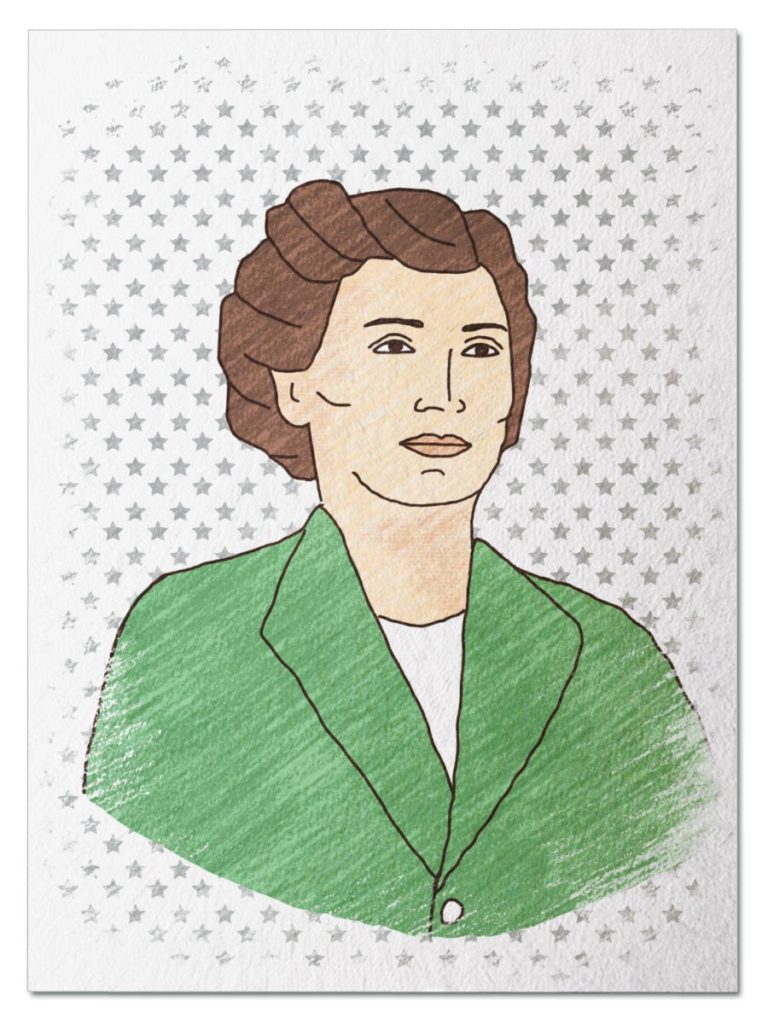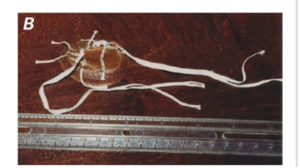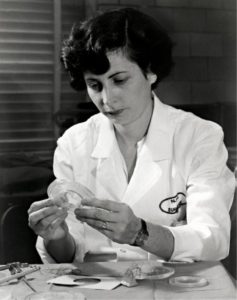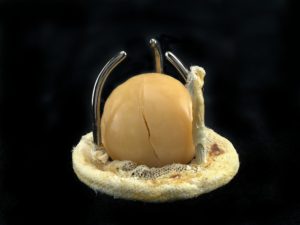
Health Hero
She had a pioneer spirit – becoming a doctor in an era when it was a man’s profession and a heart surgeon when it was a brand new and unchartered specialty. She used her artistic talent and engineering skills to create an artificial mitral valve for the heart. She spent night after night at her kitchen table working on prototypes. One night she sewed teflon strips on a valve that she used to perform the first mitral valve replacement surgery in the world. Transport yourself to a 1960 operating room at the National Institute of Health and meeting Nina Starr Braunwald…
Her Ruby Shoe Moment
The Power of the Wand
Her Yellow Brick Road
Brains, Heart & Courage
Glinda’s Gallery
Just the Facts
Her Ruby Shoe Moment
Nina Starr Braunwald stood in one of the National Institute of Health (NIH) operating rooms. She was gloved, masked and gowned, waiting for her patient to be wheeled into the theater. Nina was a NIH staff cardiac surgeon who divided her time between the research lab and the operating room. And now she was just minutes away from beginning the world’s first mitral valve replacement surgery. If she succeeded, today’s date, March 11, 1960, would go down in history.

Nina in surgery wtih Andrew Morrow (NIH Office of History and & National Library of Medicine)
Cardiac surgery was a brand new field. Before WWII, doctors believed that operating on the heart was impossible. Nina, a cardiac surgeon, and her husband Eugene, a cardiologist, had spent several years at the NIH working to understand how to fix a broken heart. Eugene’s research focused on understanding how the heart worked. Nina’s research centered on how to use surgical techniques to repair heart damage.
They both saw many patients dealing with the aftereffects of rheumatic fever, which was known to attack the heart. In some people, inflammation caused by the fever narrowed the mitral valve, located between the left atrium and left ventricle. Oxygenated blood must flow through the mitral valve before it is pumped through the body, and if blood can’t pass through easily, the consequences can be fatal. Nina wanted to help these patients, but too many of them had mitral valves too damaged to be surgically repaired. They needed a new valve, and Nina got to work figuring out how to make one. One of her prototypes was now on the surgical table waiting to be implanted in the patient.
Nina was the lead surgeon on the case, which was exciting and also sobering, as she was ultimately responsible for any result, good or bad. As a 32 year old woman in a field completely dominated by men, she also knew that any failure would likely be attributed to her gender and age. She was the world’s first woman heart surgeon – she didn’t want to be the last. She was pregnant with her second child, had a toddler daughter at home, and wanted her daughters to have the chance to be anything they wanted to be.

Braunwald-Morrow valve used in first mitral valve replacement surgery (NIH)
Nina looked over at her mentor, Dr. Andrew Morrow, who had scrubbed in to assist. He had been an excellent sounding board and partner in her mitral valve research. She did one last inspection of the artificial valve she would be placing in her patient’s heart, making sure the strips she had sewn onto the valve herself – at her kitchen table – were still secure.
As the patient was brought into the room, Nina reviewed her history: a 44 year old woman with heart failure caused by a damaged mitral valve who would die if nothing was done. Once her patient was safely under anesthesia, Nina made the incision and attached the cardiopulmonary bypass machine. She then removed the damaged valve and replaced it with the artificial one. As it was the first time anyone had ever done this procedure, Nina’s surgical decisions were educated guesses and she had to be ready to improvise. She breathed a sigh of relief as she closed the incision and sent her patient to the recovery room.

Nina inspecting one of her heart valves (NIH)
Nina stayed at the hospital with her patient after the surgery to observe the recovery firsthand. She knew she wouldn’t be able to sleep if she went home anyway, and wanted to be the one there to handle any complications that could arise from this unprecedented procedure. Fortunately, the recovery was uneventful, and her patient went home feeling better and stronger than she had in years.
Four months later, Nina received devastating news. Her patient had died from a sudden heart attack. Nina worried that her fear of that an artificial valve could collect blood and, over time, cause a fatal blood clot, had come true. The patient’s family agreed to an autopsy to determine whether the artificial valve caused her death. The coroner concluded that the valve had worked as intended. There were no blood clots present, and the heart attack likely had been caused by an irregular heart rhythm. While Nina was relieved, she knew that even though her first patient hadn’t died from a clot, the next one might.
 She spent a lot of time in her NIH lab working to improve her valve with the support of Cutter Laboratories. She made changes to fortify its structure to avoid blood collecting and clotting in any deformities over time. Her new version, the Braunwald-Cutter valve, featured a cloth-covered mechanical ball. It was implanted in thousands of patients until it was replaced by the next generation in 1979. Some patients lived with Nina’s valve for 30-40 years.
She spent a lot of time in her NIH lab working to improve her valve with the support of Cutter Laboratories. She made changes to fortify its structure to avoid blood collecting and clotting in any deformities over time. Her new version, the Braunwald-Cutter valve, featured a cloth-covered mechanical ball. It was implanted in thousands of patients until it was replaced by the next generation in 1979. Some patients lived with Nina’s valve for 30-40 years.
The Power of the Wand
Nina was an excellent mentor and teacher to many young doctors, just like Dr. Morrow was to her. She generously shared credit for research and helped her mentees build their professional reputations. Since she was one of the only female cardiac surgeons in the country, women considering the career sought her advice, which she was always willing to share. Even today, only 5% of cardiothoracic surgeons in the United States are women. As recently as 2014, Dr. Erin Mills Iannacone became the first woman cardiothoracic surgeon at Cornell University.
A teen who both embraced Nina’s ingenuity and benefited from the type of mentoring Nina provided is Hiba Hussain. Hiba, who wants to be a pediatrician, was a student in Andrew Bramante’s science classroom, which was profiled in The Class. Hiba was just 15 when she developed a low cost way to diagnose chronic obstructive pulmonary disease using a key card and an app to analyzing a patient’s breath. She was a Grand Award Winner at the 2018 Intel International Science & Engineering Fair.
Her Yellow Brick Road
Nina started her general surgical residency at Bellevue Hospital in New York in 1952. She was only the second woman resident ever admitted to its program. Surgery had a reputation for being a difficult specialty populated with temperamental people, and Bellevue was no exception. During one operation, Nina was chosen to assist the Chief of Surgery. Her job was to stand on a stool and pull the incision open with a retractor to provide the surgeon with a clear line of sight. She held that position for over an hour without faltering. Yet when the surgery took a bad turn, the Chief kicked the legs of the stool out from under Nina in a fit of rage. She fell backwards and hit her head on the floor.

Nina in 1963 in her lab (Dr. Eugene Braunwald)
When her husband Eugene received a job offer from the National Institute of Health in Bethesda, Maryland, Nina still had a year left in her residency. Fortunately, Georgetown University, only 10 miles away, had room for her in its program, and she transferred there. Nina’s skill and work ethic won her the chief resident honor. She spent the year on call, often spending nights at the hospital. Nina embraced the change, and found something that Bellevue didn’t offer: the brand new field of cardiac surgery.
She began working with Dr. Charles Hufnagel, the cardiac surgeon who designed the first artificial aortic valve. Nina assisted him during his operations and grew to love the challenge of navigating the ever-evolving map of the heart. She stayed at Georgetown for an extra year for a cardiac surgery fellowship with Dr. Hufnagel, also earning a Masters of Science in Surgery for her work in transplant tissue modeling. Nina developed a quiet and patient manner in the operating room – she didn’t kick any stools during surgery!

Braunwald-Cutter Heart Valve (Smithsonian National Museum of American History)
NIH offered Nina a job at the end of her fellowship year, but she quickly grew restless with a research only existence – she wanted to operate! Private practice wasn’t an option because most doctors wouldn’t refer their surgical patients to a woman. Nina received an offer to be a staff surgeon at a San Francisco hospital system, but decided to stay with the NIH and look for ways to incorporate surgery into her research.
Through his cardiology research, Eugene often crossed paths at the NIH with National Heart Institute Chief of Surgery, Dr. Andrew Morrow. When Eugene introduced Nina to him, Morrow was impressed with Nina’s cardiac surgery experience, interest, and intellect. He asked her to work with him, beginning a 10 year professional relationship. Morrow was a generous mentor. He gave Nina first author credit in many of their academic articles, sponsored her for medical society memberships, and nominated her for awards.
 Nina and Morrow spent many hours working on an artificial mitral valve for the heart. They chose Dacron-polyurethane material because it was flexible. This allowed the valve’s flaps to move easily so blood could pass through unimpeded. They added Teflon strips to function as the chordae tendinae (“heartstrings”) holding the valve in place. Nina spent night after night at her kitchen table working on and refining the design. She tested the valve in the veterinary surgical theater, using it to replace mitral valves in 24 dogs with heart damage. She grew confident that the Braunwald-Morrow valve would work and was ready to try it in the right patient.
Nina and Morrow spent many hours working on an artificial mitral valve for the heart. They chose Dacron-polyurethane material because it was flexible. This allowed the valve’s flaps to move easily so blood could pass through unimpeded. They added Teflon strips to function as the chordae tendinae (“heartstrings”) holding the valve in place. Nina spent night after night at her kitchen table working on and refining the design. She tested the valve in the veterinary surgical theater, using it to replace mitral valves in 24 dogs with heart damage. She grew confident that the Braunwald-Morrow valve would work and was ready to try it in the right patient.
Brains, Heart & Courage
Nina spent her childhood in Brooklyn, New York, where she attended the local public schools. She loved art and building things, spending much of her spare time drawing, painting, and sculpting. Her dad was a doctor and she grew up wanting to follow in his footsteps. She began focusing on the sciences, and became a member of the American Society of Amateur Microscopers when she was 14.
Nina stayed near home for college, enrolling at New York University, where she met a fellow pre-med student in her organic chemistry class. His name was Eugene Braunwald. They bonded over how tough the class was, the pressure they felt to excel, their Jewish upbringings, and a shared love of classical music. Their first date was to a concert where the orchestra performed Beethoven’s Seventh Symphony. It was one of Nina’s favorites and she was very impressed with Eugene’s choice (he didn’t tell her he’d gotten the tickets for free!).

Nina at home with Eugene and her two oldest daughters (NIH)
The couple applied to NYU’s medical school and were overjoyed when they both were accepted. When it came time for Nina and Eugene to decide their specialties, their paths diverged. Eugene wanted to be a cardiologist who solved the mysteries of the heart. Nina had always enjoyed working with her hands and decided on surgery, even though it was considered a masculine specialty that was too demanding for women.
Nina and Eugene got married a week after their 1952 medical school graduation. After a honeymoon in Bermuda, they returned to New York to begin their residencies at two different hospitals: Nina at Bellevue and Eugene at Mount Sinai. They found an apartment in the city that was in the middle of the two.
Glinda’s Gallery
Just the Facts
- Nina was born on March 2, 1928 in Brooklyn, New York.
- In 1963, Nina became the first woman ever certified by the American Board of Thoracic Surgery.
- Nina served as Deputy Chief of the NIH Clinic of Surgery from 1965 to 1968.
- In 1967, Nina was the first woman admitted as a member of the American Association for Thoracic Surgery (AATS). She was the only woman member for 22 years.
- Nina took her role as a working mother very seriously. She worked through each of her three pregnancies, operating until it became too difficult to reach the table and stand for extended periods of time. She started her day early to do housework and spend time with her three daughters before work. She also made a point to be home for dinner and bedtime, even if it meant returning to the hospital afterwards to check on her patients. Reporters loved to write stories about the contrast of her being a trailblazer woman surgeon with a husband and family. She found all the media attention funny.
- Nina moved to California in 1968 when Eugene was offered the Chair of Medicine position at the University of California San Diego (UCSD). UCSD hired Nina as an Associate Professor of Surgery. She helped UCSD establish a cardiac/cardiothoracic surgery training program and was eventually appointed its Acting Director. While she was there, Nina helped develop a surgical treatment for chronic thromboembolic pulmonary hypertension (damage to the heart caused by blood clots in the lungs) and UCSD still has the world’s largest program for patients who need this treatment.
- In 1972, Nina accepted a position as Associate Professor of Surgery at Harvard University, becoming the first woman on its surgical faculty. Nina’s research there focused on treating congenital heart defects. She also developed a cardiopulmonary bypass unit specifically for pediatric and neonatal use to improve surgical outcomes for children and was Deputy Director of Harvard’s MD/PhD Medical Scientist Program. She also served on the NIH Surgery and Bioengineering Study Section and the Harvard Medical School Admissions Committee.
- Nina was never granted tenure at any of the academic institutions where she taught, researched, and operated – even though she published 150 peer reviewed publications and was a pioneer in her field.
- Nina’s three daughters followed their mom into health care careers. Karen is a psychologist, Allison is an endocrinologist and Jill is a healthcare attorney.
- Nina died of cancer on August 5, 1992 at age 64. In memoriam, Eugene established the endowment for the Nina Starr Braunwald Award. The Association of Women Surgeons awards this honor for “sustained, outstanding contributions to the advancement of women in surgery.” The AWS also sponsors The Starr Medical Student and Resident Research Forum, which was founded to “facilitate interaction and idea exchange between students interested in surgery, surgical residents, and faculty members of various institutions.”
- The Thoracic Surgery Foundation sponsors two awards named for Nina. The Nina Starr Braunwald Research Fellowship is awarded to support women cardiac surgical trainees with their research. The Nina Starr Braunwald Research Award is given to women who have completed their training to support their academic research.
Want to Know More?
Braunwald, Nina Starr. “It Will Work: The First Successful Mitral Valve Replacement”
Lee, Thomas H. Eugene Braunwald and the Rise of Modern Medicine (Harvard University Press 2018).
Braunwald, Eugene. “Nina Starr Braunwald: Some Reflections On The First Woman Heart Surgeon” (The Annals of Thoracic Surgery March 2001).
Sabharwahl, Nikhil et al. “Nina Braunwald: A Female Pioneer in Cardiac Surgery” (Texas Heart Institute Journal April 2017).
Staff. “Dr. Nina Starr Braunwald” (National Institute of Health June 3, 2015).
